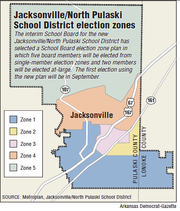The interim Jacksonville/ North Pulaski School Board has selected an election-zone plan for the new district that will result in a seven-member board with five members elected from single-member zones and two members elected at-large.
The first time the plan will be used is the annual school board election in September.
“This is the first big decision we had to make,” said Daniel Gray, president of the interim board. “Our School Board made it unanimously. It speaks to our desire as a community to be united in this.”
Jacksonville and northern Pulaski County residents voted overwhelmingly in September to form their own 100-square-mile, 4,000-student district apart from the Pulaski County Special School District.
The Arkansas Board of Education followed up on the community vote by issuing an order creating the new district and appointing an interim board to serve until elections in September.
The order calls for the new district to remain the responsibility of the Pulaski County Special district until representatives of the two districts complete negotiations on the division of students, employees, assets and debts, which could take up to two years.
Jerry Guess, superintendent of the Pulaski County Special School District, asked the Metroplan regional planning organization late last year to draft a variety of board election-zone plans for the interim Jacksonville/ North Pulaski School Board to consider.
Some of the proposals called for seven election zones that would produce a seven-member board. Other plans would have divided the district into five zones, producing a five-member board.
Gray called the plan selected last week “a blended plan” of zoned and at-large elected positions — a model different from the seven single-member zone plans traditionally used in the Little Rock, North Little Rock and Pulaski County Special school districts.
The blended plan appealed to Gray, he said, because it is used by other districts that he considers to be well-managed, such as Bryant, Fayetteville, Springdale, Fort Smith and West Memphis.
“It just made a whole lot of sense. It was a great option for us,” he said.
“I’m so sick of the zone mentality where everyone was fighting for just their zone,” he said about the Pulaski County Special district. “There was a ‘what can I get for us?’ kind of mentality.
“The two at-large members will allow everybody in the school district to have three representatives on the school board instead of just the one board member from their zone,” Gray said.
“I think that really resonated with the community,” he said, but he also noted that there were some residents — including the leadership of the local NAACP chapter — that opposed the blended plan.
Gwendolyn Harper, the NAACP’s Jacksonville branch president, said Friday that her organization strongly preferred an election-zone plan in which there would be seven single-member zones.
The resulting seven zones would be smaller, and the board member representing each zone would be more responsive to the community there, Harper said.
“The two at-large positions are the problem,” Harper said.
“We don’t think the people in the two at-large positions would have to be responsible to anybody. They wouldn’t have to answer to anybody. We don’t think the representation would be there with a five-and-two system.”
The interim members of the Jacksonville/North Pulaski board are eligible to run for the elected positions later this year.
The new board is expected to have at least one new member because none of the current board members lives in the north Pulaski County election zone, which is Zone 5.
One board member will have to be elected from that zone, Gray said.
Each of the five new zones has 7,424 to 7,920 residents.
Four of the five zones have majority-white populations.
Zone 2, which is generally north of Military Road and east of Spring Street, has a slightly higher black population than white.
The interim board has five black members and two white.
Phyllis Stewart, chief of staff for the new district, said every seat on the seven-member board will be open for election in September.
Once the new members are elected, they will draw for terms ranging from two to four years, Stewart said.
The different lengths will create staggered terms so not all board seats are up for election at the same time.
Two members will have two-year terms, three will have three years and two will have four years.
In ensuing elections, all board members will have fouryear terms, Stewart said.

